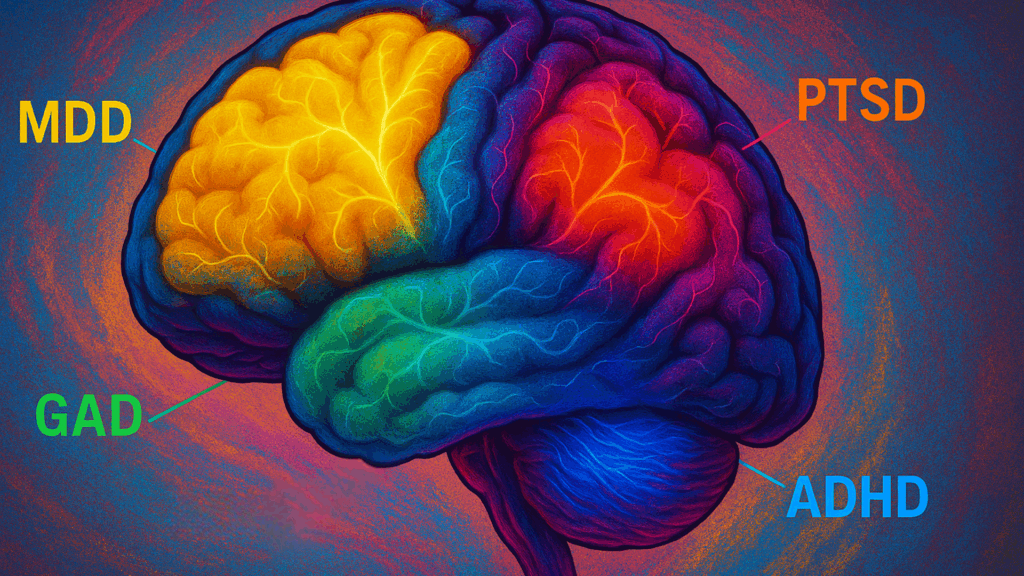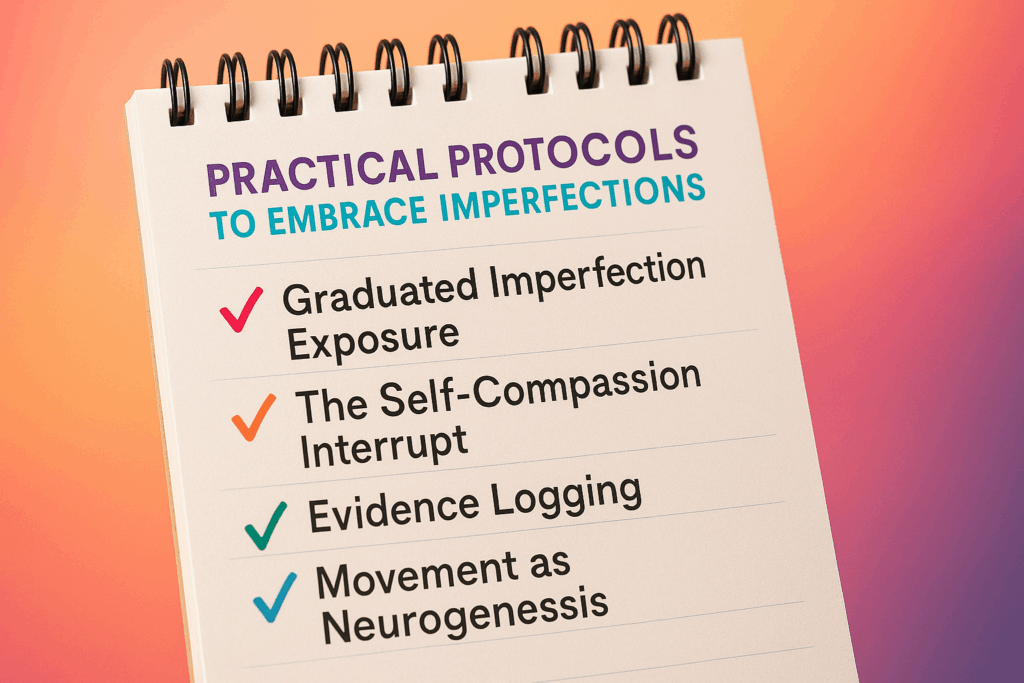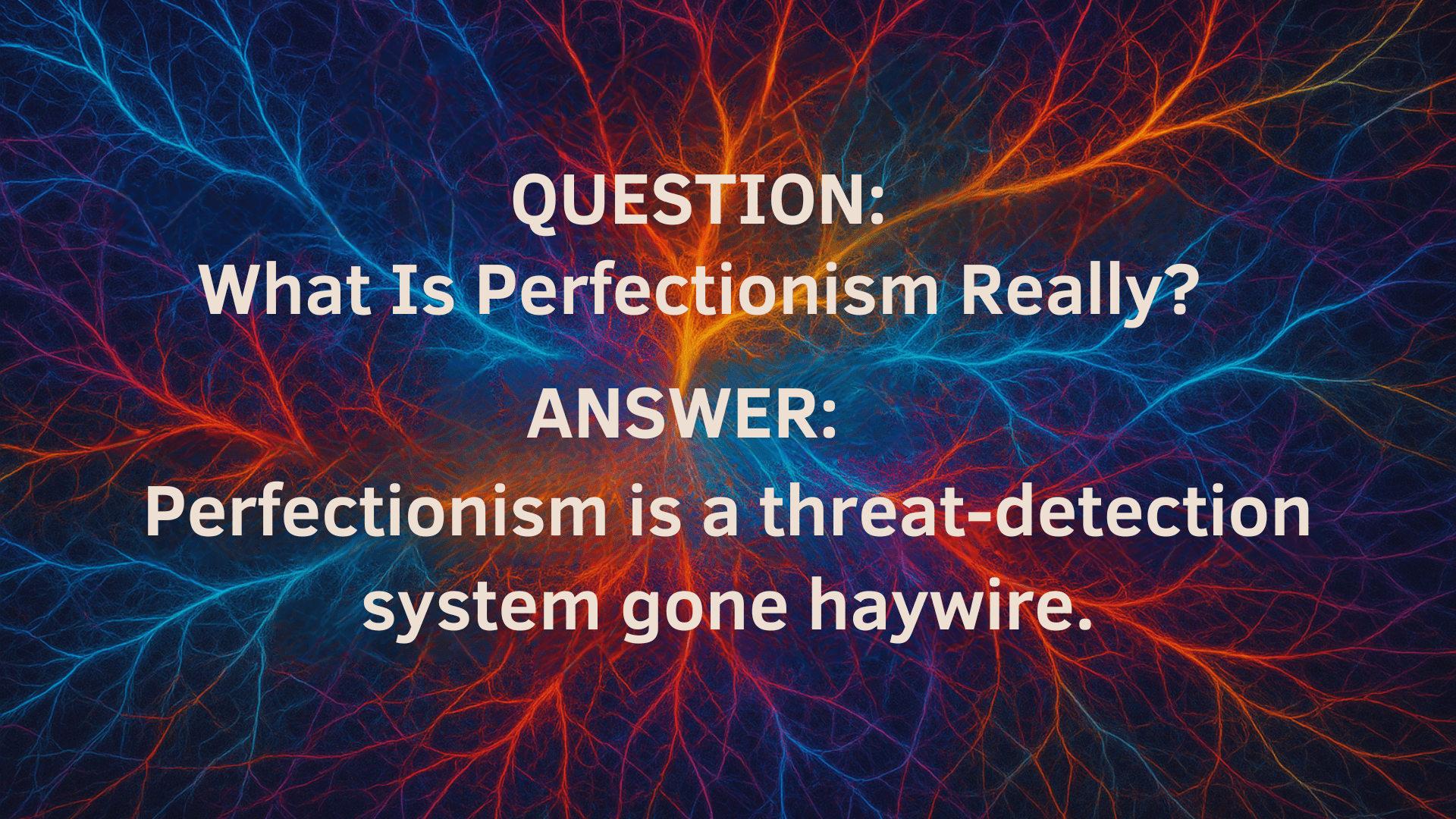Stop Trying to Be Perfect
Embrace imperfections. These two simple words can have varying effects depending on the individual. If you’re a high achiever, a perfectionist, or someone whose nervous system has been trained to treat mistakes like threats, those words probably feel impossible. You might even perceive them as irresponsible. But here’s what I want you to understand: your resistance to embrace imperfections isn’t a character flaw. It’s neuroscience.
Have you ever sent an email and then spent the next 20 minutes rewriting it because one sentence didn’t sound quite right? Have you ever felt proud of your work for five seconds before thinking of how it could be better? Have you ever sabotaged something good because it wasn’t perfect enough? If you answered yes to any of these, you’re not broken. You’re just living in a brain that hasn’t learned to embrace imperfections yet.
Here’s the truth that changes everything: you don’t need to learn how to embrace imperfections because you’re lazy or because you lack ambition. You need to embrace imperfections because your brain has been wired, through years of experience, maybe even trauma, to treat anything less than perfect as a threat. Your perfectionism isn’t a character strength. It’s a nervous system response. And the remarkable news is that you can rewire it.
After 25 years of working with high-performing executives, anxious professionals, and individuals struggling with ADHD, depression, and trauma, I’ve discovered something that neuroscience is now proving definitively: the people who embrace imperfections successfully aren’t the ones who lack drive. They are the ones who have mastered the process of altering their brains. They understand that to embrace imperfections isn’t weakness—it’s the gateway to genuine excellence, resilience, and freedom.
Your brain isn’t designed to chase perfection. It’s designed to learn, adapt, and grow. But perfectionism hijacks that system. It floods your nervous system with stress, narrows your thinking, and traps you in a cycle where nothing you do ever feels beneficial enough. The voice that tells you you’re never good enough isn’t your true voice. It’s a neural pathway that’s been strengthened through repetition, and the beautiful reality is that you can rewire it through neuroscience-backed practices.
This blog reveals exactly what’s happening in your brain, why you struggle to embrace imperfections, and how to literally rewire the neural circuits that have been driving your perfectionism. The science is clear. Your brain can change. The question is, are you ready to let it?

What Perfectionism Really Is (From a Neuroscience Perspective)
Most people think perfectionism is about wanting things to be good. It’s not. Perfectionism is an overactive threat-detection system. Your brain’s amygdala, the threat-alarm center, has learned to treat imperfection, mistakes, and criticism as dangers. When your brain perceives danger, it activates your fight-flight-freeze response, flooding your body with stress hormones like cortisol and adrenaline. This is why perfectionism feels urgent, necessary, and impossible to turn off.
Understanding this reaction is crucial because it changes everything. You can’t willpower your way out of a threat response. You have to rewire it. When you embrace imperfections, you’re essentially teaching your brain that mistakes aren’t threats. This teaching only sticks when you practice it repeatedly, which is where neuroplasticity comes in.
In individuals with ADHD, perfectionism often develops as a compensatory strategy. The ADHD brain struggles with executive function, organization, planning, and follow-through. Perfectionism feels like a way to regain control. But this approach creates a vicious cycle. Your brain already exerts significant effort in managing attention and impulse control. Add perfectionist demands on top of that, and your nervous system becomes chronically dysregulated. You can’t embrace imperfections when your brain is running in survival mode.
Anxiety amplifies perfectionism. When your brain is wired for threat detection, perfectionism becomes a way of trying to prevent bad things from happening. If you do everything perfectly, maybe you’ll be safe. Maybe you won’t be criticized. Maybe you won’t fail. But this logic creates a prison. You’re constantly trying to earn safety through performance, which means you can’t embrace imperfections—they feel like a threat to your survival.
Depression often follows perfectionism. When your standards are impossibly high and you’re inevitably imperfect, depression’s narrative of worthlessness finds fertile ground. You’ve already been telling yourself you’re not good enough. Depression just agrees with you and amplifies the message. This is why people with depression struggle to embrace imperfections; their brain has already decided they’re the problem.
The Neuroscience of How Perfectionism Gets Wired Into Your Brain
Your brain contains roughly 86 billion neurons. Each neuron can connect to thousands of others through tiny gaps called synapses. When neurons fire together repeatedly, when you practice the same thought, emotion, or behavior over and over, those synaptic connections strengthen. This is Hebb’s Law: neurons that fire together wire together. This is the mechanism that built your perfectionism, and it’s also the mechanism that allows you to embrace imperfections.
Every time you engage in perfectionist thinking, when you criticize yourself for a mistake, when you set impossibly high standards, when you catastrophize about minor failures—you’re strengthening the neural pathways associated with that thinking. Imagine these pathways as hiking trails through a forest. The first time you walk a new path, it’s barely visible. But after years of walking the same path, it becomes a deep, well-worn groove that your brain naturally defaults to because it’s the most efficient route.
This is why perfectionism feels automatic. Your brain has spent years, sometimes decades, strengthening these neural pathways. When faced with a task, your brain doesn’t deliberate. It just follows the path of least neural resistance straight to perfectionism.
However, the good news is that neuroplasticity operates on both sides. The same mechanism that built perfectionism can build something different. When you practice new thoughts, new responses, and new behaviors, you’re literally rewiring your brain. This isn’t motivational thinking. It’s neurobiology.
The process is called “long-term potentiation,” the strengthening of synapses through repeated stimulation. When you repeatedly practice embracing imperfections, when you respond to mistakes with compassion instead of criticism, and when you deliberately do things imperfectly in low-stakes situations, you’re engaging in neural training. Each repetition weakens the old perfectionist pathways and strengthens new, healthier pathways.
Your brain also has the capacity for “long-term depression,” the weakening of unused synaptic connections. When you stop practicing perfectionism and redirect your attention elsewhere, those neural pathways gradually weaken from disuse. They don’t disappear immediately, but they become less dominant, less automatic, and less controlling.
Why Your Brain Became Perfectionist (Early Wiring and Trauma)
Perfectionism seldom emerges spontaneously. It usually has roots in early experience. Perhaps you grew up in an environment where love felt conditional. You were valued for your achievements, your grades, and your accomplishments, not for simply existing. Your developing brain made a logical adaptation: it strengthened the neural pathways associated with achievement and fear of failure. Through years of practice, perfectionism became your brain’s operating system.
Maybe you experienced critical parenting, where mistakes were punished or ridiculed. Your brain learned that mistakes weren’t just normal human experiences; they were threats to your safety or status. The amygdala—your threat-detection center, got trained to treat mistakes as emergencies.
For trauma survivors, perfectionism often emerges as a survival strategy. If you experienced trauma—abuse, violence, loss, or betrayal, your brain may have concluded that if you were just perfect enough, you could have prevented it. This false logic is heartbreaking but also deeply understandable. When your brain is threatened, it searches for control. Perfectionism feels like control. It feels like safety. Your brain wired perfectionism into the deepest layers because it was trying to protect you.
Individuals with PTSD particularly struggle with this. The trauma response has taught your amygdala to stay hypervigilant, constantly scanning for danger. Perfectionism and hypervigilance feed each other. You’re scanning for potential mistakes the way your brain scans for external threats—with the same urgency and the same intensity.
The reason I’m emphasizing this is critical: understanding how your perfectionism got wired changes your relationship with it. You’re not broken. Your brain did exactly what it was designed to do. It learned from its environment and adapted. This reframe is essential because shame about your perfectionism only strengthens it. When you can embrace imperfections, including the imperfection of having perfectionism, you create the psychological space for change.

Perfectionism in PTSD, Depression, Anxiety, and ADHD
Each mental health condition interacts with perfectionism in specific ways, which means rewiring requires specificity.
Perfectionism and PTSD
In trauma survivors, perfectionism often masks deep hypervigilance. The person who seems to “have it all together” is usually exhausted underneath. Their amygdala is in constant red alert, searching for signs of danger. They embrace imperfections only in safe relationships, if at all. Rewiring perfectionism in PTSD involves gradually updating the brain’s threat assessment system. As you repeatedly experience that imperfection doesn’t lead to disaster, the amygdala’s threat sensitivity decreases. The change happens slowly, but it does.
Perfectionism and Depression
Depression feeds on perfectionism’s impossible standards. The more perfectionist you become, the more inevitable your failure is, and the more fuel depression has. Depression tells you you’re worthless anyway, so why try? The brain gets caught between perfectionism’s demands and depression’s hopelessness. To embrace imperfections when you’re depressed feels impossible because depression has already decided you’re the problem. Treating such symptoms requires addressing the neurochemistry of depression, often through medication or neuroscience-based interventions, while simultaneously building new neural pathways around self-compassion.
Perfectionism and Anxiety
Anxiety thrives on perfectionism. Your brain is already scanning for threats, and perfectionism provides endless material. There’s always something you could do better, something that could go wrong, or something that needs fixing. Anxiety and perfectionism create a feedback loop: anxiety drives perfectionism, and perfectionism generates more anxiety about whether you’re being perfect enough. To embrace imperfections with anxiety requires tolerating discomfort while practicing new responses. Your nervous system will resist; your brain will argue that imperfection is dangerous. But with repeated practice, your brain learns that imperfection is survivable.
Perfectionism and ADHD
In ADHD, perfectionism often emerges as compensation for executive dysfunction. Your brain struggles with organization, planning, and task initiation, so perfectionism feels like a way to regain control. But ADHD perfectionism is particularly cruel because it combines an already-dysregulated nervous system with impossible standards. The result is often paralysis: the ADHD brain can’t meet the perfectionist demands, so it avoids, procrastinates, and then crashes. Breaking this cycle means embracing imperfections in a structured way—completing tasks at 70% quality instead of waiting for perfection, celebrating effort over outcome, and building systems that don’t depend on perfectionism.
The Power of Neuroplasticity: Rewiring Perfectionism Through Practice
Here’s where the science gets genuinely exciting: if perfectionism was built through repeated practice, it can be rebuilt through different repeated practice. This is neuroplasticity in action: your brain’s fundamental capacity to reorganize itself based on new experience and learning.
The key is understanding what drives neuroplasticity. Your brain rewires most powerfully in response to:
First, novel experiences that grab your attention. When you do something new or unexpected, your brain releases dopamine and activates the learning centers. This is why trying something new—even something small and imperfect, can shift neural patterns.
Second, repetition. One imperfect experience doesn’t rewire decades of perfectionism. But 100 imperfect experiences, practiced consistently over weeks and months, gradually shift the neural landscape. Your brain needs practice to build new grooves.
Third, emotional significance. Changes that matter emotionally stick faster than intellectual understanding alone. When you practice embracing imperfections and discover that nothing terrible happens, that discovery carries emotional weight. Your brain updates its threat assessment.
Fourth, self-compassion. When you practice embracing imperfections with kindness instead of judgment, you activate different neural networks than when you practice with criticism. Research shows that self-compassion activates the brain’s soothing system, areas associated with oxytocin and dopamine, while self-criticism activates the threat system. To embrace imperfections in a way that actually rewires your brain, you need to practice with compassion.
The practical implication is profound: you don’t have to achieve perfect imperfection to embrace flaws. You just have to practice, repeatedly, with attention and compassion.

The Perfectionism Paradox—Why High Performers Sabotage Their Own Success
Here’s something that will shake your understanding of achievement: the most successful people often aren’t the most perfectionist. In fact, research in neuroscience and performance psychology reveals something almost counterintuitive. When you embrace imperfections, you actually perform better. This contradicts everything our culture tells us about success, which is precisely why most people miss it.
The paradox works like this. Perfectionism floods your system with cortisol, the stress hormone. Chronic cortisol exposure actually shrinks your hippocampus, the brain region essential for learning, memory formation, and creative problem-solving. Meanwhile, your prefrontal cortex, the area responsible for strategic thinking, innovation, and nuanced decision-making, gets starved of resources. Your brain essentially becomes a threat-detection machine rather than a creative engine.
When you embrace imperfections, something neurologically remarkable happens. Your cortisol levels normalize. Your prefrontal cortex gets more neural resources. Your dopamine, the motivation and reward neurotransmitter, increases. Suddenly, you’re thinking more clearly, generating more creative solutions, and actually working more effectively. You’re performing at a higher level while experiencing less stress. This is the secret that elite performers have figured out, often through trial and error: to embrace imperfections is to unlock your highest potential.
I worked with a senior executive at a Fortune 500 company who embodied this paradox. She was brilliant, accomplished, and completely burned out. Her perfectionism led her to revise presentations until midnight, rewrite emails five times, and question previously made decisions. Her team was terrified of her feedback. Her results were excellent, but her nervous system was in constant dysregulation.
When we started working on helping her embrace imperfections, submitting work at 90% quality, making decisions more decisively, and trusting her expertise, something shifted. Her stress markers dropped. Her creativity increased. Her leadership became warmer. And here’s the part that surprised even her: her team’s performance improved. When leaders embrace imperfections, they give permission for their teams to do the same. The entire organizational nervous system shifts from threat mode to growth mode.
This shift happens because the brain is fundamentally social. Your nervous system literally synchronizes with the nervous systems around you. When your amygdala is in threat mode because of perfectionism, everyone around you feels it. Everyone gains when you accept your flaws and your nervous system relaxes. This is why embracing imperfections isn’t selfish or lazy; it’s actually a gift you give to everyone you work with.
The neuroscience here is about resource allocation. Your brain has finite neural resources. When perfectionism consumes 40% of your cognitive bandwidth, that’s 40% not available for strategy, creativity, relationship-building, or adaptive thinking. When you embrace imperfections and that cortisol-driven perfectionism releases its grip, suddenly you have enormous mental resources freed up. High performers who understand these principles have already figured out that embracing imperfections is the path to sustainable excellence.

The Self-Compassion Effect—Why Kindness Rewires Your Brain Faster Than Discipline
Most people think they need to be harder on themselves to improve. They believe that self-criticism is motivational, that embracing imperfections means lowering their standards, and that compassion equals weakness. This belief is neurologically backwards. It’s one of the most consequential misunderstandings about how brains actually change.
When you criticize yourself for mistakes, you activate your brain’s threat system. Your amygdala floods your system with cortisol and adrenaline. You’re literally putting yourself in a stressed state. In stress states, your brain downshifts from creative, strategic thinking into survival mode. You can embrace imperfections intellectually all day long, but if your nervous system is in threat mode, your brain won’t rewire the perfectionist patterns. You’re essentially trying to reprogram your nervous system while it’s in full alarm.
Self-compassion works differently. When you respond to your mistakes with kindness, “I’m human, this happens, I’m doing my best,” you activate your brain’s parasympathetic nervous system, the “rest and digest” system. You release oxytocin and increase vagal tone, the vagus nerve’s ability to regulate your nervous system. Your brain isn’t in threat mode. It’s in a state of relative safety. In safety, your prefrontal cortex can actually engage. New learning can happen. Neural pathways can rewire.
Here’s the neurological magic: when you embrace imperfections with self-compassion repeatedly, you’re literally training your brain to respond to mistakes differently. Each time you notice a mistake and respond with kindness instead of criticism, you’re practicing a new neural pathway. That pathway strengthens. Eventually, self-compassion becomes your brain’s default response. You embrace imperfections automatically, without the exhausting internal struggle.
Research from neuroscientists studying self-compassion shows measurable differences in brain structure. People who practice self-compassion show increased gray matter in areas associated with emotional processing and decreased activity in the amygdala. Meanwhile, people who practice self-criticism show the opposite pattern: amygdala hyperactivity and reduced emotional regulation capacity. If you want to embrace imperfections in a way that actually sticks neurologically, self-compassion is non-negotiable.
One of my clients, a high-achieving attorney, initially resisted this. He believed that self-compassion would make him soft, that he needed his inner critic to drive him. But when we looked at the neuroscience, he understood. He started practicing responding to his mistakes with the same compassion he’d offer a junior attorney making the same error. Within weeks, something shifted. He still had high standards. He still performed excellently. But the anxiety that had plagued him for decades began to ease. He was able to embrace imperfections without the associated dread. His perfectionism had been rooted in fear; his new excellence was rooted in capability.
The profound implication is that, in order to embrace imperfections successfully, you don’t need more discipline. You need more compassion. Your brain isn’t broken because you make mistakes. Your brain is designed to make mistakes as part of learning. When you embrace imperfections with compassion, you’re finally working with your brain’s design rather than against it. You’re rewiring not through punishment, but through practice in a state of safety. This is how lasting change actually happens neurologically.

Practical Protocols to Embrace Imperfections
Based on neuroscience and 25 years of clinical coaching, here are the most effective protocols for rewiring perfectionism:
Protocol 1: Graduated Imperfection Exposure
Choose a low-stakes area where you’re willing to experiment with “good enough.” This might be your emails, your home organization, your fitness routine, or your work presentation. For two weeks, intentionally lower your standard by 20 to 30 percent. Notice what happens. Most people discover that the world doesn’t end. Their job doesn’t disappear. Relationships don’t crumble. This is critical information for your brain. Each time you embrace imperfections without catastrophe, you’re literally rewriting the neural pathway that says imperfection equals disaster.
Protocol 2: The Self-Compassion Interrupt
When you notice the perfectionist voice saying, “This should be better,” “I should have done more,” or “I’m not good enough,” Pause. Place your hand on your heart. Take three slow breaths. Then speak to yourself exactly as you would to a struggling friend. This practice works because it activates different neural networks than self-criticism. You’re literally switching on the compassion circuits while switching off the threat circuits. By practicing this multiple times, you are effectively rewiring the response your brain naturally defaults to.
Protocol 3: Evidence Logging
Please maintain a straightforward log for four weeks. Each time you embrace imperfections and nothing catastrophic happens, write it down. Include the situation and the outcome. Over time, you’re building a neural database of evidence that contradicts your perfectionist beliefs. Your brain stores this evidence, and the perfectionist narrative gradually loses influence as the contradictory information accumulates.
Protocol 4: Movement as Neurogenesis
Aerobic exercise is one of the most potent neuroplasticity tools available. Thirty minutes of moderate-intensity exercise most days literally generates new neurons and strengthens the connections between your prefrontal cortex (rational thinking) and your amygdala (threat detection). This biological change makes it easier to embrace imperfections because your brain has more neural resources for rational perspective. I recommend this regimen as foundational for anyone rewiring perfectionism.
Protocol 5: Meaning-Making Reframe
Instead of seeing imperfections as failures, reframe them as data points. “What did this teach me?” “What would I do differently?” This cognitive shift activates your prefrontal cortex and reduces amygdala-driven reactivity. When you embrace imperfections as information-gathering rather than threat-signaling, the emotional intensity decreases dramatically.
Protocol 6: Deliberate Vulnerability
Find one person you trust and practice sharing something imperfect. Maybe it’s admitting you made a mistake, asking for help, or sharing something you’re struggling with. This practice does something powerful neurologically: it updates your brain’s social threat assessment. You discover that vulnerability doesn’t lead to rejection or judgment. Your brain gradually learns that being imperfect is safe in relationships.
Section 8: How Mental Health Conditions Shape the Rewiring Process
The rewiring process isn’t one-size-fits-all. Your mental health baseline shapes how quickly and easily you can embrace imperfections.
For ADHD: Your challenge is that your executive function is already taxed. Rewiring perfectionism requires breaking it into smaller, more manageable pieces. Instead of trying to embrace imperfections in everything at once, pick one specific area. Celebrate completion at 70% quality. Build systems that don’t depend on willpower or perfectionism. As your nervous system becomes less overwhelmed, you’ll find it easier to embrace imperfections more broadly.
For Anxiety: Your brain is already threat-scanning, so imperfection feels dangerous. The rewiring here involves gradual exposure. Start with tiny imperfections in very safe contexts. Notice that your anxiety decreases as nothing bad happens. Your brain is learning through direct experience that imperfection is survivable. This approach takes time and patience, but it works.
For Depression: Your brain needs evidence that you’re worthy despite imperfection. This is why “taking in the good” is so important. When you complete something at 80% quality instead of waiting for perfection, consciously notice and celebrate that. Your brain needs to build new associations between effort and self-worth, not between achievement and self-worth.
For PTSD: Your amygdala’s threat sensitivity needs gradual updating. The protocols above work, but they often need to be combined with trauma-specific interventions like EMDR or somatic work. Your brain is protecting you against a threat that’s no longer present. Embracing imperfections is part of the conversation, but updating the trauma response is essential.

Section 9: Building Your Rewired Future
The neuroscience is unambiguous: your brain can chttps://mindlabneuroscience.com/science-behind-neuroplasticity/
hange. The perfectionism that feels so permanent, so essential to who you are, is actually just a neural pattern. Patterns can be rewired.
Here’s what I want you to understand: this procedure isn’t about becoming lazy or complacent. It’s not about accepting mediocrity. Accepting imperfections releases significant mental and emotional energy that perfectionism had been consuming. You can use that energy for creativity, connection, innovation, and genuine excellence, which stems from capability and vision rather than fear.
The people I work with who successfully embrace imperfections don’t become less driven. They become differently driven. Instead of running from the threat of imperfection, they’re running toward growth and authenticity. And here’s the neurological magic: that positive motivation generates more dopamine, more resilience, and actually better outcomes than fear-based motivation.
Your brain spent years, maybe decades, wiring perfectionism. Rewiring it won’t happen overnight. But if you practice consistently, if you embrace imperfections through graduated exposure, self-compassion, and repeated experience, your brain will change. The old neural pathways will weaken. New pathways will strengthen. What once felt impossible will start to feel natural.
The question isn’t whether you’re capable of change. Neuroscience proves you are. The question is, are you willing to practice? Are you willing to embrace imperfections, repeatedly, with compassion, trusting that your remarkable brain will wire itself differently? If you are, the transformation is already underway.

Frequently Asked Questions: Embrace Imperfections and Transform Your Brain
If I embrace imperfections, won’t I just become lazy and stop pushing myself?
No, this is one of the biggest misconceptions about embracing imperfections. When you stop using perfectionism as your motivator, you don’t lose drive; you fundamentally change where your motivation comes from. Perfectionism is fear-based motivation; you’re running away from failure.
When you embrace imperfections, you shift to capability-based motivation; you’re running toward growth. Neuroscience demonstrates that when you engage your prefrontal cortex (rational thinking) instead of your amygdala (threat response), capability-based motivation actually yields superior results. Your standards don’t drop; they become more intelligent and sustainable.
How long does it actually take to rewire my brain if I embrace imperfections consistently?
Most people start noticing shifts within 2–3 weeks of consistent practice. However, meaningful neurological rewiring typically takes 8–12 weeks of deliberate, repetitive practice. The timeline depends on how long you’ve been practicing perfectionism (longer = more deeply wired = longer rewiring time) and how consistently you practice new responses.
I’ve worked with executives who’ve spent 30 years building perfectionism; their rewiring took 6-9 months. But here’s the encouraging part: you don’t have to wait months to start feeling better. Many clients report reduced anxiety and increased clarity within weeks of beginning to embrace imperfections.
What if my workplace culture rewards perfectionism? How do I embrace imperfections in a competitive environment?
The issue is a legitimate concern, and the answer is strategic. You don’t have to embrace imperfections everywhere at once. Start in low-stakes areas, internal communications, personal projects, and areas where good enough truly is good enough. As you develop more capacity to embrace imperfections without triggering anxiety, you can expand.
Interestingly, when leaders embrace imperfections strategically, it often shifts organizational culture. Your team gives themselves permission to do the same. Productivity often increases because people aren’t paralyzed by perfectionism. The competitive edge actually comes from psychological flexibility, not rigid perfectionism.
I have ADHD/anxiety/depression/PTSD. Will these practices still help me embrace imperfections?
Yes, absolutely, and often, these conditions make embracing imperfections even more essential. ADHD brains especially benefit because perfectionism creates an unsustainable feedback loop. Anxious brains need to embrace imperfections to break the threat-detection cycle.
Depressed brains need to embrace imperfections as evidence that worthiness isn’t conditional on perfect performance. PTSD brains need to embrace imperfections to update the false belief that perfection equals safety. The practices may look slightly different depending on your diagnosis, but the neurological principle remains the same: your brain can rewire itself when you practice new responses consistently.
If I embrace imperfections, won’t people judge me or think I’m not competent?
This fear usually reflects what we call “threat anticipation,” your amygdala predicting catastrophe. When you accept flaws, most people don’t notice, and those who do often respect your authenticity and vulnerability.
When leaders embrace imperfections openly, their teams see them as more human, more trustworthy, and paradoxically more competent because they’re making decisions from wisdom rather than fear. This principle has been true in every organization where I’ve worked with executives to embrace imperfections. The judgment you fear is usually coming from inside your brain, not from the people around you.
#NeuroplasticityCoaching #EmbraceImperfections #BrainScience #PerfectionismRecovery #NeuroscienceHealing #MindsetTransformation



